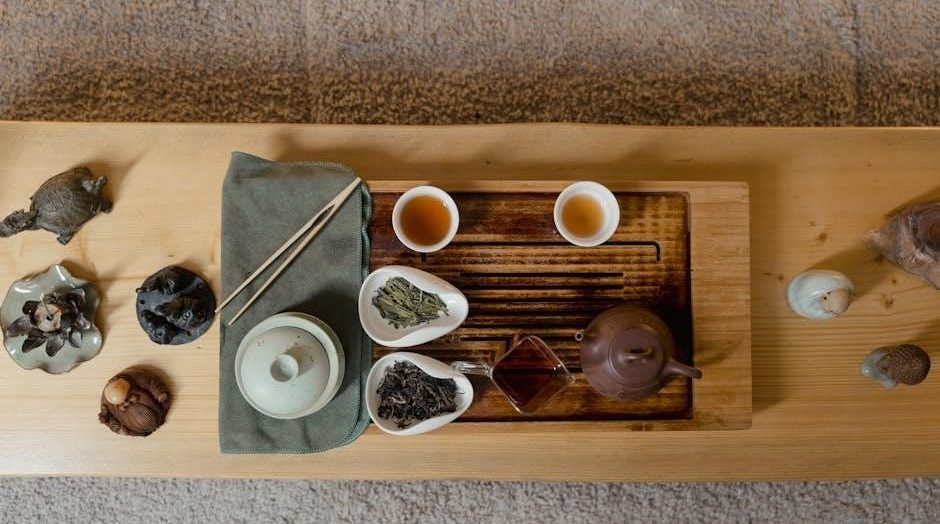Brewing tea is an art that combines tradition and personal preference. Understanding the basics, such as water temperature and steeping times, enhances the experience. Explore the world of tea with this guide to perfect your brew.
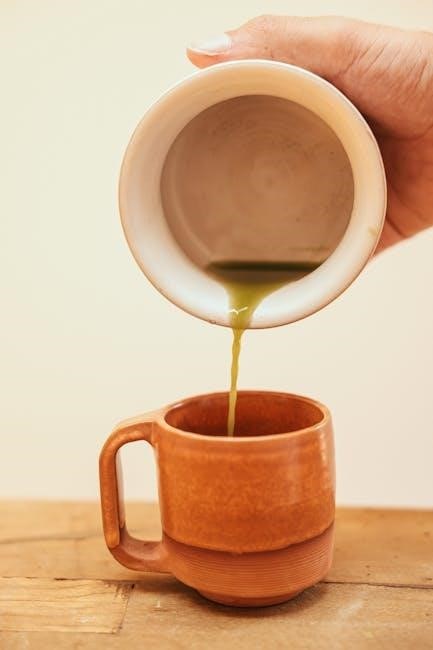
1.1. Importance of Proper Brewing Techniques
Proper brewing techniques are crucial for unlocking the full flavor and aroma of tea. Using the right water temperature and steeping time ensures a balanced extraction, preventing bitterness or under-extraction. These methods preserve the tea’s natural qualities, enhancing the overall drinking experience. Whether using loose leaves or tea bags, correct techniques bring out the unique characteristics of each variety. A well-brewed cup not only satisfies the palate but also allows for greater appreciation of the tea’s complexity and cultural significance.
1.2. Overview of the Brewing Process
The brewing process involves a series of steps that transform raw tea leaves into a flavorful beverage. It begins with heating water to the ideal temperature, which varies by tea type. Next, the right amount of tea leaves or tea bags is added to the pot or cup. Steeping follows, allowing the flavors to infuse into the water. The duration depends on the tea variety, with black teas typically steeping longer than green or white teas. Finally, the leaves or bags are removed, and the tea is ready to enjoy. This simple yet precise process ensures optimal flavor extraction and aroma release.
Essential Tools and Equipment for Tea Brewing
The right tools elevate your tea-brewing experience. A quality teapot, kettle, tea infuser, and strainer are essentials. Tea cups or mugs complete the setup for a perfect brew.
2.1. Teapots: Materials and Sizes
Choosing the right teapot is crucial for optimal brewing. Materials like ceramic, glass, or stainless steel retain heat well and are ideal for even extraction. Ceramic teapots are popular for their durability and heat retention, while glass allows for visual monitoring of the brew. Stainless steel teapots are sleek and easy to clean. Sizes range from small, single-serve options (0.5 liters) to larger pots (up to 2 liters) for sharing. Selecting the right size ensures the perfect tea-to-water ratio and enhances the overall brewing experience.
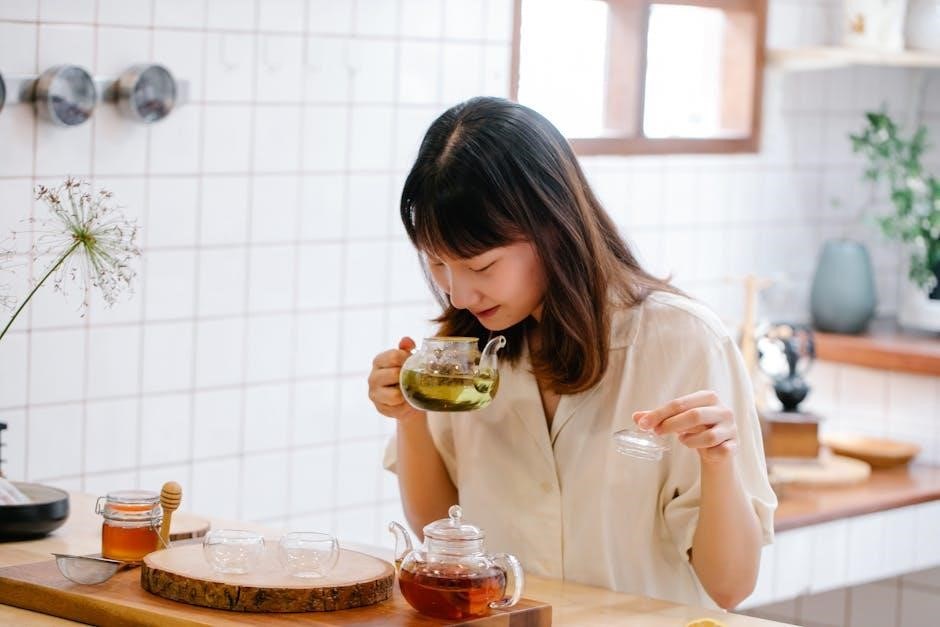
2.2. Tea Infusers and Strainers
Tea infusers and strainers are essential for loose-leaf tea brewing, allowing leaves to unfurl and release their flavors. Stainless steel, silicone, or mesh infusers are popular for their durability and ease of cleaning. Some feature fine holes to prevent small leaves from escaping, ensuring a clean cup. Strainers, often built into teapots or sold separately, serve the same purpose. Both options enhance the brewing process by keeping leaves contained while steeping. Choosing the right infuser or strainer can elevate your tea experience and make loose-leaf brewing more convenient and enjoyable.
2.3. Kettles: Stovetop vs. Electric
Kettles are a cornerstone of tea brewing, with stovetop and electric models offering distinct advantages. Stovetop kettles provide traditional control over water temperature and are often made of durable materials like stainless steel, copper, or ceramic. Electric kettles, however, offer convenience and speed, with rapid boiling and features like variable temperature settings. Some electric models include keep-warm functions, while others have automatic shut-off for safety. Both options are viable, but electric kettles are preferred for precise temperature control, a key factor in brewing specialty teas. Choose based on your preference for speed, convenience, or traditional brewing methods.
2.4. Tea Cups and Mugs
Tea cups and mugs are essential for enjoying the perfect brew. Choose materials like ceramic, glass, or porcelain for optimal flavor preservation. Handle design and size matter; smaller cups are ideal for concentrated flavors, while larger mugs suit hearty blends. Consider thermal retention properties—thicker mugs keep tea warmer longer. Aesthetics also play a role; vibrant designs can elevate the brewing ritual. Ultimately, the right cup enhances both the aroma and taste, making it a personal yet practical choice for every tea enthusiast. Balance functionality and style to find your perfect match.

Understanding Tea Varieties
Tea comes in diverse types, each with unique origins and characteristics. From black to green, white, oolong, and herbal, understanding these varieties is key to selecting the right brewing techniques for each type, ensuring a perfect cup every time.
3.1. Black Tea: Origins and Characteristics
Black tea originates from China and is now produced worldwide, with major growers including India, Kenya, and Sri Lanka. It undergoes full fermentation, making it robust and dark in color. Known for its rich, complex flavors, black tea offers a strong, malty taste with hints of sweetness. Popular varieties include Assam, Darjeeling, and Ceylon. Black tea contains more caffeine than green tea, making it a favorite for those seeking a energizing brew. Its bold profile pairs well with milk and sugar, enhancing its versatility for both traditional and modern tea drinkers alike.
3.2. Green Tea: Differences from Black Tea
Green tea differs from black tea in its processing, as it is not fermented, preserving its natural antioxidants. The leaves are either steamed or pan-fried to halt oxidation, resulting in a lighter, more delicate flavor. Originating in China and popularized in Japan, green tea offers varieties like Sencha and Dragon Well. With lower caffeine content than black tea, it is favored for its refreshing, grassy notes and potential health benefits. Green tea requires cooler water (160–170°F) and shorter steeping times to prevent bitterness, making it a unique and nuanced choice for tea enthusiasts seeking a lighter brew.
3.3. White Tea: Rarity and Delicacy
White tea is the rarest and most delicate of all teas, made from the young buds of the tea plant, minimally processed to preserve its natural essence. Originating in China, particularly in Fujian Province, white tea is known for its light, silky texture and subtle floral notes. Its minimal oxidation and gentle handling result in a tea that is both fragrant and refreshing. With a lower caffeine content, it is ideal for those seeking a soothing brew. White tea is a true delicacy, offering a refined drinking experience for those who appreciate its nuanced charm and rarity.
3.4. Oolong Tea: Partial Fermentation Process
Oolong tea is uniquely processed through partial fermentation, placing it between green and black teas in character. This intricate process involves withering, rolling, and a controlled oxidation period, which is halted by firing. The result is a tea with complex, smooth flavors, ranging from floral to nutty notes. Oolong teas offer a balanced taste, making them versatile for various brewing methods. To bring out their full potential, steep oolong leaves in water heated to 195°F for 3-5 minutes. Gongfu brewing is ideal for multiple infusions, allowing the drinker to experience the tea’s evolving profile.
3.5. Herbal Tea: Caffeine-Free Options
Herbal teas, also known as tisanes, are caffeine-free infusions made from herbs, fruits, and flowers. Popular varieties include chamomile, peppermint, and hibiscus. These teas are brewed similarly to traditional teas but require boiling water (212°F) and a steeping time of 5-7 minutes. Herbal teas are enjoyed for their soothing properties and distinct flavors. They offer a calming alternative for those seeking a caffeine-free option. With endless options to explore, herbal teas provide a delightful way to unwind and experience the diversity of botanical flavors.
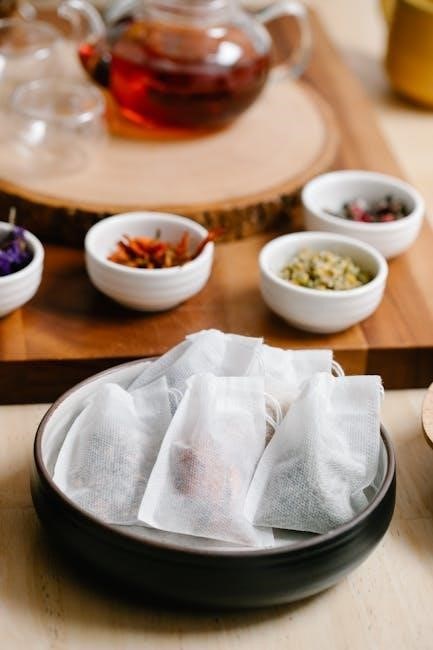
The Brewing Process
Brewing tea involves essential steps like water quality, temperature, and steeping time. These factors ensure a perfect cup, balancing flavor and aroma for a delightful experience.
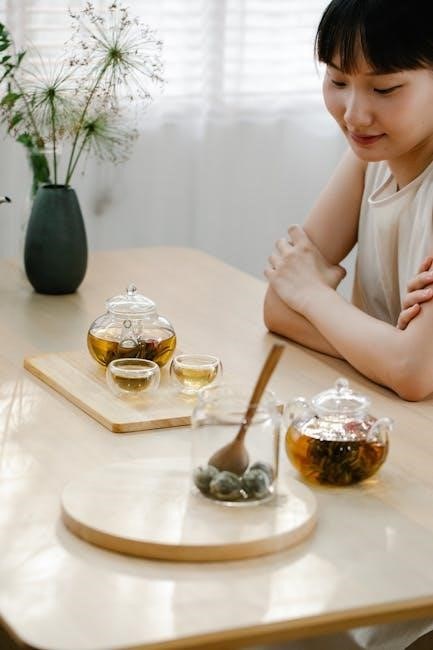
4.1. Water Quality and Temperature
Water quality and temperature are crucial for brewing tea. Use filtered water to avoid impurities that can affect taste. Black and herbal teas require boiling water (212°F), while green and white teas thrive at lower temperatures (160-170°F). Oolong tea falls in between, ideally at 180-200°F. Adjusting temperature prevents bitterness and ensures optimal extraction of flavors and aromas, making it essential for a perfect brew.
4.2. Measuring Tea Leaves: Loose Leaf vs. Tea Bags
Measuring tea leaves is essential for a balanced brew. For loose leaf, use 1-2 teaspoons per 8oz cup, depending on desired strength. Adjust based on leaf size, as larger leaves may require less. Tea bags are more convenient, with one bag per cup. For stronger tea, use two bags or steep longer. Loose leaf offers more flexibility in flavor and aroma, while tea bags provide consistency. Experiment to find your perfect measure, ensuring optimal extraction for your preferred taste.
4.3. Steeping Times for Different Tea Types
Steeping times vary significantly across tea types. Black tea typically steeps for 3-5 minutes, while green tea requires 2-4 minutes. White tea needs 4-5 minutes, and oolong can range from 2-7 minutes, depending on oxidation. Herbal teas usually steep for 5-7 minutes. Adjust times based on personal preference for strength and flavor. Over-steeping can lead to bitterness, especially in delicate teas. Covering the tea during steeping helps maintain temperature and ensures even extraction. Experiment with timings to find your perfect cup, as small adjustments can greatly impact the final flavor profile.
4.4. Tea-to-Water Ratio: Adjusting for Strength
The tea-to-water ratio is crucial for achieving the perfect brew. Generally, use 1-2 teaspoons of loose-leaf tea per 8oz cup of water for black tea, and 1 teaspoon for green or white tea. Adjust based on desired strength: more leaves yield a bolder flavor, while fewer allow the tea’s natural notes to shine. Oolong and herbal teas may require slightly different ratios, but the principle remains the same. Experiment to find your ideal balance, ensuring the flavors are neither overpowering nor underwhelming. This simple adjustment can elevate your brewing experience significantly.
Advanced Brewing Techniques
Explore methods like Gongfu brewing, cold brew, and iced tea for unique flavors. These techniques require precise temperature, steeping times, and ratios to refine your brewing process and customize your perfect cup.
5.1. Gongfu Brewing: Traditional Chinese Method
Gongfu brewing is a traditional Chinese method emphasizing precision and ritual. It uses small teapots and multiple infusions to maximize tea leaf potential. This social, meditative practice highlights the tea’s complexity. Key elements include Yixing teapots, high-quality leaves, and controlled water temperature, quantity, and steeping times. Each infusion reveals unique flavors, fostering a deep connection with the tea. Perfect for enthusiasts seeking to explore tea’s full profile, Gongfu brewing combines artistry and tradition, offering a transformative experience for those willing to master its techniques.
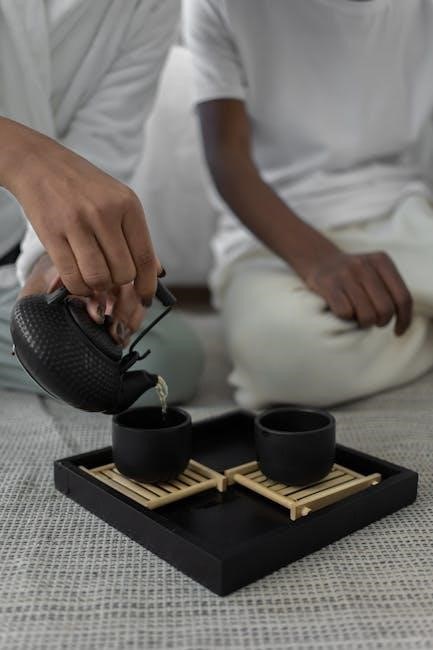
5.2. Cold Brew: Perfect for Summer
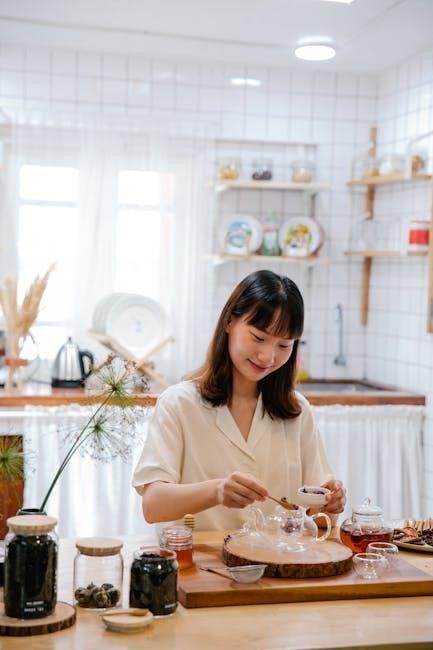
Cold brew tea is a refreshing, modern method ideal for hot weather. It involves steeping loose tea leaves in cold water for 8-12 hours, resulting in a smooth, less bitter flavor. Perfect for summer, this technique avoids the need for heat, preserving delicate tea notes. Use 1-2 teaspoons of loose leaves per 8oz of water. Steep overnight in the fridge for optimal taste. Cold brew is versatile, working well with black, green, or herbal teas. Adjust steeping time to suit your preference for strength and sweetness. It’s a hassle-free way to enjoy tea year-round, especially during warmer months.
5.3. Iced Tea: Tips for Brewing Perfection
Iced tea is a refreshing twist on traditional brewing, perfect for warm weather. Start by brewing a strong hot tea, then chill it in the fridge. For a smoother flavor, try cold-brewing tea leaves directly in cold water for 8-12 hours. Adjust steeping times based on the tea type—black teas steep for 3-5 minutes, while green teas prefer 2-3 minutes. Serve over ice with optional additions like lemon, mint, or honey. Experiment with ratios and flavors to create your ideal iced tea blend. This method ensures a crisp, revitalizing drink every time.
Enhancing Your Brewing Experience
Elevate your tea ritual by adding milk, sugar, or honey, and pairing with complementary foods. Creating a mindful brewing routine enhances flavor and enjoyment, making each sip delightful.
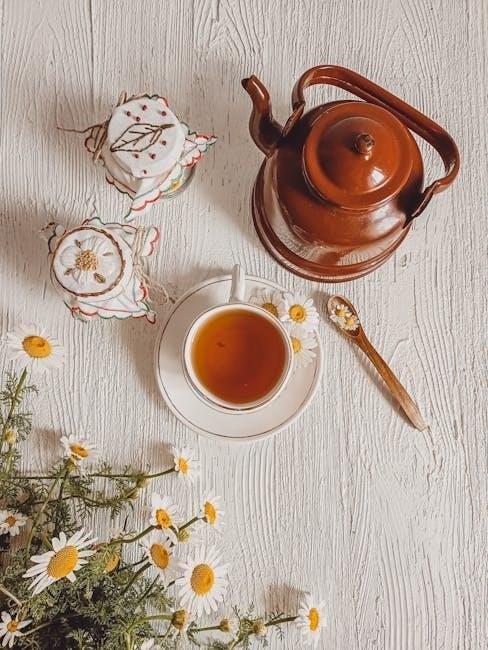
6.1. Adding Milk, Sugar, or Honey
Enhance your tea with milk, sugar, or honey to tailor the flavor to your taste. Milk adds creaminess, balancing bitterness in black teas, while sugar or honey provide sweetness. For a healthier option, honey offers a natural alternative to refined sugars. Experiment with proportions to find your perfect blend. Some teas, like chai, traditionally include milk and sugar, while others, like green tea, pair well with honey. These additions transform a simple brew into a personalized delight, allowing you to enjoy tea in a way that suits your preferences and enhances your overall experience.
6.2. Tea Pairings: Food and Snacks
Pairing tea with the right foods and snacks elevates your brewing experience. Black teas like Earl Grey complement robust flavors such as chocolate or spiced foods. Green teas, with their delicate profiles, pair well with lighter options like sushi or salads. Herbal teas, especially fruity ones, are perfect with fresh fruits or cheeses. Oolong teas often match nuts or baked goods. Experiment with combinations to find your favorites, as the right pairing can enhance both the tea’s flavor and the accompanying dish, creating a harmonious and enjoyable experience.
6.3. Creating a Tea Ritual
Creating a tea ritual transforms brewing into a mindful experience. Start by preparing a serene environment, free from distractions. Use high-quality tea tools and select a tea that resonates with your mood. Heat water to the ideal temperature, measure leaves precisely, and steep with intention. Savor the aroma, observe the infusion, and enjoy the flavors. Incorporate moments of gratitude or reflection to deepen the experience. Personalize the ritual with music, art, or meaningful objects. Over time, this practice becomes a cherished routine, fostering mindfulness and connection to the simple joy of tea.
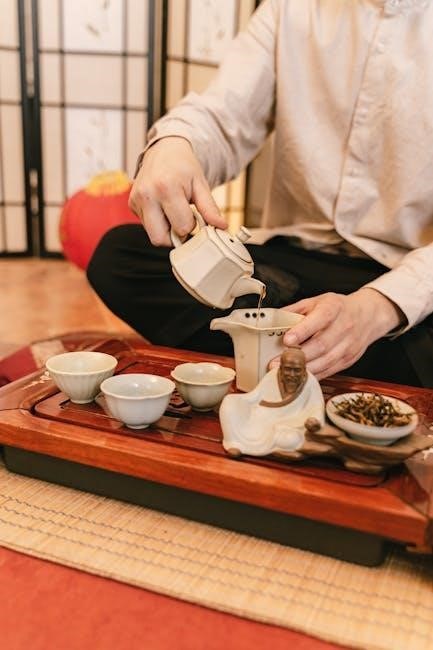
Troubleshooting Common Issues
Addressing bitter or weak tea, adjust steeping times and temperatures. Ensure proper storage to maintain freshness and avoid stale flavors, enhancing your overall brewing experience.
7.1. Bitter Tea: Causes and Solutions
Bitter tea often results from high water temperature, over-steeping, or excessive tea leaves. To fix, reduce steeping time, lower water temp, or use less tea. Adjusting techniques ensures balance and prevents harsh flavors in your brew. Proper storage also helps maintain tea quality, avoiding stale or bitter notes. Experiment with ratios and methods to achieve a smoother taste. Balancing these factors enhances enjoyment and prevents unpleasant bitterness in every cup.
7.2. Weak or Under-Extracted Tea
A weak or under-extracted tea often results from insufficient steeping time, too little tea leaves, or water that’s not hot enough. To address this, increase the tea-to-water ratio or extend the steeping time slightly. Ensure water reaches the optimal temperature for the specific tea type. Experimenting with these adjustments can help achieve a balanced flavor. Avoid overcompensation, as it may lead to bitterness. Fine-tuning these elements will enhance the extraction and deliver a more satisfying brew. Patience and small adjustments are key to perfecting the process.
7.3. Storing Tea Properly
Proper tea storage is crucial for maintaining flavor and aroma. Use airtight containers to protect tea from light, moisture, and air. Store in a cool, dark place, like a pantry. Avoid proximity to strong-smelling foods, as tea can absorb odors. Opt for glass or tin containers over plastic for better preservation. Keep tea away from heat sources and humidity. This ensures a longer shelf life and optimal quality. Proper storage prevents staleness and preserves the tea’s natural characteristics, allowing you to enjoy it at its best. Consistent conditions are key to maintaining freshness and flavor.
Brewing the perfect cup of tea is a balance of tradition and creativity. Experiment with techniques, tools, and varieties to find your ideal blend. Cheers to your tea journey!
8.1. Summary of Key Brewing Tips
Mastering tea brewing begins with understanding water quality, temperature, and steeping times. Use fresh, filtered water and heat it to the optimal temperature for your tea type. Measure tea leaves accurately, adjusting for strength and personal preference. Steeping times vary—delicate teas like green or white require shorter infusions, while black and herbal teas can steep longer. Experiment with ratios and techniques to customize your brew. Proper storage of tea leaves ensures freshness and flavor. By following these guidelines, you can consistently craft the perfect cup and enjoy the full potential of your tea.
8.2. Encouragement to Experiment
Tea brewing is a deeply personal journey, and experimentation is key to finding your perfect cup. Don’t be afraid to try different steeping times, temperatures, and tea-to-water ratios to tailor your brew to your taste. Explore various tea varieties and techniques, such as cold brew or iced tea, to discover new flavors. Add milk, honey, or herbs to create unique twists. Remember, there’s no right or wrong—only the joy of exploration. Embrace the process, and let every sip bring you closer to your ideal cup of tea.
